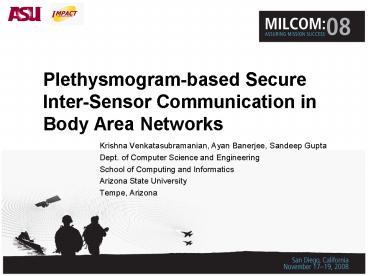Krishna Venkatasubramanian, Ayan Banerjee, Sandeep Gupta - PowerPoint PPT Presentation
1 / 13
Title:
Krishna Venkatasubramanian, Ayan Banerjee, Sandeep Gupta
Description:
BAN - A network of health & environmental monitoring sensors deployed on a ... Pair-wise, Network-wise, Group-wise. Pre-deployed Master Key ... – PowerPoint PPT presentation
Number of Views:142
Avg rating:3.0/5.0
Title: Krishna Venkatasubramanian, Ayan Banerjee, Sandeep Gupta
1
Plethysmogram-based Secure Inter-Sensor
Communication in Body Area Networks
- Krishna Venkatasubramanian, Ayan Banerjee,
Sandeep Gupta - Dept. of Computer Science and Engineering
- School of Computing and Informatics
- Arizona State University
- Tempe, Arizona
2
Body Area Network
- Definition
- BAN - A network of health environmental
monitoring sensors deployed on a person managing
their health. - Principal Features
- Continuous real time monitoring
- Remove time space restrictions on care
- Improved deployability
- Ideal for life-saving scenarios
- Enables caregivers on field to make informed
decisions about treatment of soldiers in
time-constrained scenarios.
3
Security in Body Area Networks
- Need
- BANs collect sensitive medical data
- Legal Requirement (HIPAA)
- Potential for exploitation
- Loss of privacy
- Physical harm
- Security Requirements
- Integrity
- Confidentiality
- Authentication
- Plug-n-Play
- Possible Attacks
- Fake warnings resource wastage
- Prevent legitimate warnings.
- Unnecessary Actuations.
Primary issue Secure Inter- Sensor Communication
in BAN
4
Traditional Approach
- Key Distribution Secure Communication.
- Pre-deployment based
- Pair-wise, Network-wise, Group-wise
- Pre-deployed Master Key
- Domain parameters for ECC based Diffie-Helman.
- Problems
- Requires secure setup and initialization process
- Re-keying and network wide adjustments node
addition, moving difficult
5
Plethysmogram based Key Agreement
- Photoplethysmogram (PPG) based Key Agreement
(PKA) - PPG volumetric change in the distention of
arteries due to the perfusion of blood through
them during a cardiac cycle - Properties
- Easy to Measure oximeter finger, ear lobe
- Universal - measurable in everyone
- Distinctive cardiac cycle unique for each
person at a give time - Low Latency requires minimal measurements for
key agreement - Time Variant varies with time
- Advantages
- Plug-n-Play deployment is enough to have secure
communication - Efficiency no additional keying material
required - Automatic Rekeying Key agreed based on current
value of PPG cannot be known from knowledge of
past values.
- System Model
- BAN
- Sensors worn or implanted on subject
- Use wireless medium to communicate
- All sensors can measure PPG
- Threats
- Active adversaries replay, spoof, introduce
messages - Passive adversaries eavesdrop only
- Tamper physical compromise UNLIKELY
- Trust
- Wireless medium not trusted
- Physical layer attacks such as jamming not
addressed
6
Details
- Feature Generation
- Extraction
- Obtaining frequency domain features from PPG
- Quantization
- For representation of features for key agreement
- Key Agreement
- Fuzzy Vault
- Cryptographic construct used for secure exchange
of data - Vault Exchange
- Key agreement between sensors using the vault
construct
7
PPG Feature Generation
8
Key Agreement
- Sensors use PPG features as a basis for agreeing
upon keys. - Features cannot be directly used a keys as they
might not be identical due to the topographic
specificity of the human body. - Technique
- Generate a key at one sensor
- Hide it using PPG features
- Transport it to other sensor
- Unhide it at the receiver
- We use Fuzzy Vault construct to hide/un-hide the
keys as it allows hiding and un-hiding even
without identical secrets
9
Fuzzy Vault
- Locks secrets S using a set of values A and can
be unlocked with another set B, only if A ? B gt ? - The construction and locking of the vault is done
by - Generating a vth order polynomial p over the
variable x that encodes the secret S, - Computing the value of the polynomial at
different values of x from set A and creating a
set R ai, p(ai), where 1 ? i ? A - Adding randomly generated points called chaff to
R which do not lie on the polynomial. - Unlocking of the vault can be done by
- Identifying a set B with significant overlap with
A - Build a set Q (u, v)(u, v) ? R, u ? B
- Polynomial reconstructed using points in Q using
Lagrangian interpolation - Knowledge of v1
points on a polynomial (x0,y0),(x1,y1).(xn,yn)
can reconstruct vth order polynomial
10
Vault Locking Unlocking
Sender
Receiver
11
Security Analysis
- Security of the vault depends upon number of
points (R) and order of polynomial (v). - Number of combinations needed for
- Adversary RC(v1)
- Receiver QC(v1)
- Choose v such that
- v less than common features between sender and
receiver of same person - v greater than common features between sender
and receiver of different person - Choose R such that
- Required amount of security available
- Computation within manageable limits for the
receiver
12
Performance Analysis
- Based on actual PPG data collected from 10
volunteers at IMPACT lab. - Smith-Medical oximeter used 60Hz sampling, 5
minutes data collected. - Properties evaluated
- Distinctiveness
- Needed for setting polynomial order
- Total features per person 30
- Common features same person 12 (average)
- Common features different person 2 (average)
- Time Variance
- Compare common features in PPG collected at
different measurement start-times for executing
PKA. - If greater than polynomial order (v) then
violation
13
Conclusion
- Implemented PKA in Matlab
- Use of PPG for cryptographic keys agreement
proposed results are promising. - Previous work on using physiological values based
on - Inter-Pulse-Interval (IPI) was useful for
authentication only - EKG was too tedious to measure reducing
usability - Future Work
- Implementation of PKA on actual sensors
- Reduce Vault unlocking overhead for receiver.
Screen Shot

